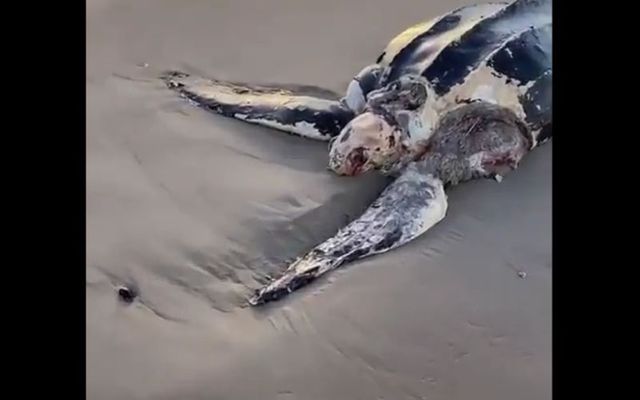The largest species of sea turtle in the world washed up on a Wexford beach last week, with many walkers blown away by its sheer size.
The leatherback sea turtle, an ultra-rare species that can weigh up to 920kg, was discovered on Curracloe Beach in Co Wexford on October 28.
The turtle had unfortunately died by the time it was discovered by walkers on the beach.
The discovery was logged with the Irish Whale and Dolphin Group (IWDG), while DNA has been collected from the turtle.
In a post on Facebook, the IWDG said it is now the official recorder of sea turtles in Ireland after a request from the National Parks and Wildlife Service.
IWDG are now the official recorders of sea turtle strandings in Ireland. The National Parks and Wildlife Service (NPWS)...
Posted by Irish Whale and Dolphin Group on Sunday, October 29, 2023
On October 30, the X (formerly Twitter) account Wexford Drone shared this up-close footage of the turtle:
Large Leatherback sea turtle washed up on Curracloe Beach this morning ?? pic.twitter.com/T2LWyHamTv
— Wexford Drone (@wexfordrone) October 30, 2023
Wexford naturalist Jim Hurley told local outlet Wexford People that it is "slightly unusual" for leatherback turtles to wash ashore in Wexford but said it is not unprecedented.
"In the past, it was thought that Leatherbacks were lost and way out of range when they turned up around the Wexford coast," Hurley told Wexford People.
"Now they are known to turn up from time to time to feed on jellyfish. Still, it would be slightly unusual to discover one."
Hurley said the turtles can sometimes mistake plastic bags for jellyfish and end up choking to death on plastic.
"It’s awful that such a big animal can live such a long life only to end up choking on someone’s rubbish."
The turtle's cause of death remains unknown but its DNA samples are set to be analyzed in the coming days.
Leatherback turtles are officially listed as an endangered species and can measure up to 1.8 meters in length. They are the only species of turtle that do not have scales or a hard shell. Instead, its carapace is covered by oily flesh and flexible, leather-like skin, from which its name is derived.
The population of leatherback turtles has declined by around 40% over the past three generations. The current world population of leatherback turtles is estimated to be between 30,000 and 40,000.




Comments